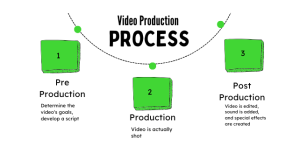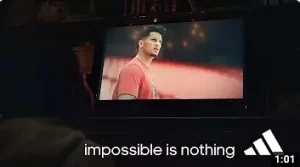What is Video Production? Complete Process of Videos Production
Reports for year 2023 mentions that people are watching on average 17 hours of online video per week. (Source)
About 86% of marketing professionals use video as a preferred marketing tool. And of these 66% consumers think that short-form videos are more engaging on social media. (Source) 92% of marketers have fetched good ROI from video marketing and they get qualified leads from videos.
The stats show that video production has high relevance. Let us read further to understand video production in detail.
What is Video Production?
Video production is the process of creating video content for any purpose. It is the equivalent of filmmaking but with video recorded as analog signals on videotape, digitally in videotape, or as computer files stored on optical discs, hard drives, SSDs, magnetic tape, or memory cards instead of film stock.
The videos production process can be broken down into three main stages:

- During the pre-production stage, the team determines the video’s goals, develops a script, storyboard, and shot list, and gathers the necessary equipment and crew.
- In the production stage, the team follows the script and storyboard and adjusts while shooting the video.
- Finally, in the post-production stage, the video is edited, sound is added, and special effects are created before being exported to its final format.
Some of the videos you can make include:
- Marketing videos: Made to promote a product or service.
- Educational videos: Made to teach people about a particular topic.
- Documentaries: These videos document real-life events or people.
- Fiction films: These videos are works of fiction, such as movies or TV shows.
- Music videos: Videos made to promote a song.
Video production is a growing field as more and more businesses and organisations use video to communicate with their audiences. If you are interested in a career in video production, many resources are available to help you learn the skills you need.
Mention The Complete Process Of Video Production
Here are the main steps involved in the complete process of video production:
- Pre-production: Under pre-production, the creation team must determine the video’s goals, develop a script, storyboard, and shot list, and gather the necessary equipment and crew.
- Define the video’s goals: Outline what is to be achieved with your video? Think is to inform, entertain, or persuade your audience?
- Develop a script: The script is the blueprint for your video. It will outline the dialogue, action, and visuals of your video.
- Create a storyboard: Prepare for the storyboard to give a visual representation of your script. It helps to visualise the shots and scenes of your video.
- Create a shot list: The shot list includes all the shots you need to capture for your video.
- Gather the necessary equipment and crew: This depends on the video type you are creating and the available budget.
- Production: In this stage you are actually engaged in creating the video. The entire crew will follow the script and storyboard and make adjustments as needed.
- Scout the location: If your video is set in a specific location, you must scout the location and ensure it is suitable for filming.
- Rent or purchase equipment: You will need to rent or purchase the necessary equipment for filming, such as cameras, lights, and sound equipment.
- Hire the crew: You must hire a team to film your video, such as a director, cinematographer, sound engineer, and editor.
- Shoot the video: The crew will follow the script and storyboard to shoot the video.
- Post-production: This is the stage where the video is edited, sound is added, and special effects are created. The video is then exported to its final format.
- Edit the video: The editor will assemble the footage into the final video. They will work with the director to create a cohesive and engaging story.
- Add sound: The sound engineer will record and mix the audio for the video. They will work to ensure that the audio is clear and understandable.
- Add special effects: The VFX artist will create special effects for the video. They use software to add or remove elements from the footage or to create entirely new scenes.
- Export the video: The video is exported to its final format, such as an MP4 or MOV file.
The video production process can be complex and time-consuming but also a creative and rewarding experience. By following these steps, you can create a video that is both informative and engaging.
Tips For Video Production:
These are the tips for video production:
- Set a budget and stick to it. Video production can be expensive, so it is important to set a budget and stick to it.
- Be flexible. Things don’t always go according to plan, so it is essential to be flexible and adaptable.
- Get feedback. Once you have a finished product, get feedback from others to improve it.
- Don’t be afraid to experiment. There are no hard and fast rules in video production. Experiment with different techniques and see what works best for you.
Equipment For Making Videos
To make marketing videos, this is what you must have:
- The most crucial equipment for creating videos is the camera. There are various types of cameras available, ranging from simple point-and-shoot cameras to advanced DSLRs and mirrorless cameras.
- To ensure stability while filming, a tripod is necessary, mainly when shooting in low light or while on the move.
- High-quality videos require good lighting, which can be achieved using various lighting options, from essential to professional studio lights.
- To record sound for your videos, a microphone is necessary, and there are many different types available, from built-in to external microphones.
- Finally, editing software is used to edit your videos after they have been shot, and there are many different options available, from essential to professional software.
Here are some additional pieces of equipment that you may want to consider:
- Gimbal: It helps to stabilise your camera footage and is used for shooting handheld video.
- Slider: Use slider to smoothly move your camera along a track. This can be used to create a variety of creative shots.
- Colour grading software: Colour grading software adjusts the colours in your videos. This can be used to improve your videos’ overall look and feel.
- Audio recording software: This software is used to record and edit audio for your videos.
The specific equipment you need will depend on the type of videos you create and your available budget.
Video Production Psychology
Video Production Psychology is about understanding and application of psychological principles and techniques in creating videos.
You have to apply aspects of psychology to create videos to effectively engage, influence, and resonate with the audience’s emotions, thoughts, and behaviours.
This field incorporates knowledge about human perception, cognition, feelings, and social interactions to enhance the impact of videos on viewers.
Key elements of- Video Production Psychology
Video Production Psychology encompasses several key elements:
- Visual and Auditory Perception: Understanding how viewers perceive visual and auditory stimuli helps design video elements that capture attention and convey messages effectively. This includes using colours, shapes, movement, and sound to create a desired emotional response.
- Storytelling and Narrative: Incorporating storytelling techniques rooted in psychology can create a strong emotional connection with the audience. A well-structured narrative can evoke empathy, suspense, or excitement, keeping viewers engaged throughout the video.
- Emotional Resonance: Videos that trigger emotions are more memorable and shareable. Video producers can create a deeper connection with the audience by tapping into emotions like joy, sadness, surprise, or fear.
- Cognitive Load and Information Processing: Considering the limits of human attention and cognitive capacity, videos should present information in a clear and digestible manner. Avoiding information overload ensures that viewers can easily understand and retain the message.
- Social Influence and Persuasion: Utilising psychological principles of persuasion, such as social proof, authority, and scarcity, can encourage viewers to take desired actions, such as sharing the video or making a purchase.
- Visual and Auditory Design: Incorporating visual aesthetics and audio design principles can enhance the overall viewer experience. Elements like framing, composition, lighting, and sound quality influence how the audience perceives the content.
- Cultural and Contextual Considerations: Understanding the target audience’s cultural backgrounds, values, and beliefs is crucial to creating videos that resonate within their specific context.
- Interactive Elements and Engagement: Incorporating interactive elements in videos, such as polls or clickable links, can increase engagement and make viewers feel more involved.
Also Read : What is social media video production?
Brand Examples Of Video Production
Some of the brand examples with impressive video production include:
- Adidas’ “Impossible is Nothing” campaign is another excellent example of video marketing done right. This campaign features athletes who have overcome adversity to achieve their goals and inspires viewers to believe in themselves.

- Volkswagen’s “The Force” Super Bowl commercial is one of the most famous video marketing examples. This commercial used humour and surprise to create a lasting impression on viewers, and it helped to make Volkswagen a more popular brand.

Conclusion
Effective video production is a dynamic blend of creativity, psychology, and technical expertise. Crafting compelling narratives, harnessing the power of visual and auditory elements, and understanding the psychology of your audience are all keys to producing impactful videos.
A well-crafted video can work wonders if you’re aiming to tell a brand story, engage your audience emotionally, or simply share valuable content.
If you’re seeking assistance in bringing your video production ideas to life, our team at Noboru World is here to help. Whether it’s planning, shooting, editing, or any aspect of video production, drop us a line at hello[at]noboruworld.com or book a call. Let’s collaborate to create videos that leave a lasting impression!
FAQ
What is the typical cost of professional video production?
The cost of professional video production is subject to a wide range of factors, including the project’s intricacy, video duration, location, equipment used, and the proficiency of the production team. A simple corporate video may cost between $1,000 to $5,000 per minute, while high-end productions or commercials can cost tens thousand or more. It is crucial to discuss your specific project with a production company to obtain an accurate estimate.
How long does it take to produce a video from start to finish?
The timeline for video production can also vary significantly, ranging from a few weeks for a short promotional video to several months or even years for more complex projects like documentaries or feature films. The production process typically involves pre-production (planning, scripting, casting), production (shooting footage), and post-production (editing, sound design, visual effects). The timeline is dependent on the project’s scope and complexity.
What equipment and software are commonly used in video production?
Video production relies on various equipment, including cameras, lenses, lighting, microphones, and tripods. Popular camera brands for professional video production include Canon, Sony, and RED.
Editing software like Adobe Premiere Pro, Final Cut Pro, and DaVinci Resolve are commonly used for post-production tasks. Specialised software may also be used for visual effects, colour correction, and sound editing.



